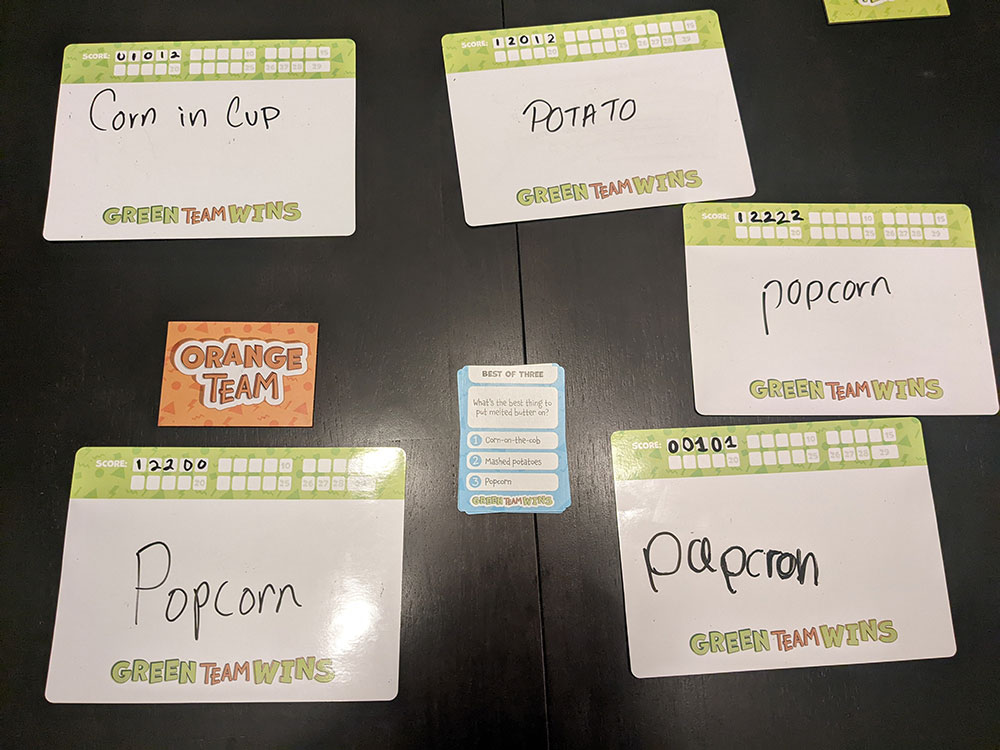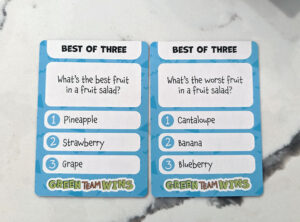 Fill in the blanks. _________ Review. __________ Game Quest. Deck of ________. If you said toilet paper, couch, and lettuce, you would be terrible at Green Team Wins. You need to think like everyone else to get on the green team and score points. If you don’t usually fit in, it’s a good time to start pretending. Otherwise, you’ll be orange like the Cheetos dust on your friend’s fingers when it’s time to play your newest $200 board game.
Fill in the blanks. _________ Review. __________ Game Quest. Deck of ________. If you said toilet paper, couch, and lettuce, you would be terrible at Green Team Wins. You need to think like everyone else to get on the green team and score points. If you don’t usually fit in, it’s a good time to start pretending. Otherwise, you’ll be orange like the Cheetos dust on your friend’s fingers when it’s time to play your newest $200 board game.
Green Team Wins is a party-style game for 3-12 players. It takes about 20 minutes to play and works for most ages.
Gameplay Overview:
In Green Team Wins, players are trying to score the most points by answering questions and matching with the most popular answer. The gameplay takes place over 15 rounds. Everyone starts on the orange team. Each round a new question is drawn. Questions come in three types: Fill in the Blank, Best of Three, and This or That.
Players secretly write their answers on their individual dry erase boards. Once all players have written down their answers, they reveal. Those who wrote the answer that was most popular, get a point and flips to the green team. Everyone else scores zero. In subsequent rounds, players who were on the green team and again match with the popular answer, stay green and score two points. If they do not match, they return to the orange team and score zero. So joining the green team gets you one point, staying on the green team gets you two points, and anything else gets you zero.
After fifteen questions are asked, points are tallied, and the highest score wins.

Game Experience:
Green Team Wins blurs the line between game and activity. Yes, there’s a score, but as with a certain subset of party games, who cares about that? This one feels like an extended ice breaker. Some questions will lead to interesting discussions or light-hearted arguments. I’m always down for that in a party game environment. While not as strong as Wavelength, it is a conversation starter. Some of the questions are ridiculous (in a good way) such as which cereal mascot is putting in the most work?
Another strength of the game is its ability to handle large player counts well. Green Team Wins plays up to 12. The more the merrier. You can bring this one anywhere and play with anyone since there are only a few rules, and they are quite simple. Those who couldn’t grasp it from the teach, understood exactly what was going on after a round or two.

There is a glaring issue that I have to mention. Many of the questions are bad. 210 question cards sounds like a lot, but honestly only maybe a third are worth asking. There’s some repetition such as two questions about fruit salad. Some questions are really obvious such as what’s the most disappointing coin (penny, nickel, or dime)? Some I just don’t care about at all (e.g. This or that: a speech at an award show or a speech at a wedding). The safest bet were the fill in the blank cards. As the person running the game, skipping question after question and sometimes settling for one that resulted in a collective groan, was not an enjoyable experience. I believe they phoned in this important part of the game design.
This game may have scored a bit higher for me had I not, by total coincidence, recently also played a game that clearly inspired this one, Herd Mentality (Coombes/Penn, 2020). Much like Green Team Wins, Herd Mentality rewards points for players who match with the majority answer. There is also a penalty if you are the most recent outcast (only person who wrote a non-matching answer). That is, you can’t win the game. I actually like that system a lot better. With Green Team Wins, you don’t even have to be on the Green Team at the end of the game to win. That’s an odd choice given the name of the game. Most importantly, the questions in Herd Mentality are all at least pretty good. They are open-ended and none have obvious answers as Green Team Wins has with some questions. I do, however, prefer the dry erase board format of Green Team Wins.
Final Thoughts:
While I had a pretty good time with Green Team Wins several times, there is some frustration with having to rifle through questions to find any that are worth asking. After a few plays, we were relying on re-using questions from previous plays. I brought this to multiple get-togethers, and people had fun with it. However, I don’t think it will be making its way back into my game bag any time soon.
Final Score: 2.5 Stars – Fun, large group activity that suffers from bad questions.
 Hits:
Hits:
• Rules are simple
• Handles a large player count well
• Gets people talking (sometimes yelling)
Misses:
• Many questions are bad
• Needs more variety/open-ended questions
• Herd Mentality does it better





















